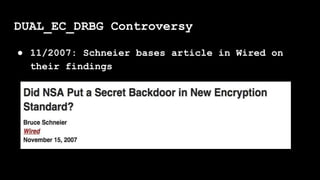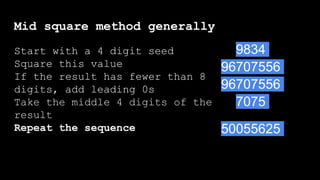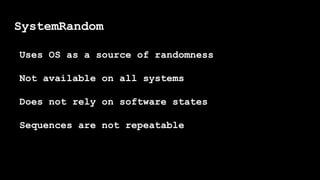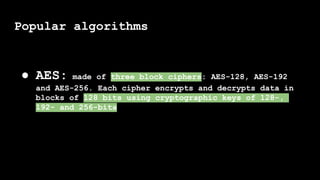Amanda Sopkin - Computational Randomness: Creating Chaos in an Ordered Machine - Codemotion Milan 2018
- 1. Computational Randomness: Controlled Chaos in an Organized Machine Amanda Sopkin @amandasopkin Milan | November 29 - 30, 2018
- 4. Where are we headed? @amandasopkin
- 9. 100 BC: Julius Caeser @amandasopkin
- 10. @amandasopkin
- 11. Bread and Butter of cryptography
- 13. To encrypt, a table of alphabets can be used, termed a tabula recta, Vigenère square or Vigenère table. It has the alphabet written out 26 times in different rows, each alphabet shifted cyclically to the left compared to the previous alphabet, corresponding to the 26 possible Caesar ciphers. At different points in the encryption process, the cipher uses a different alphabet from one of the rows. The alphabet used at each point depends on a repeating keyword 1500s: Vigenère’s system
- 15. Kerchoff’s Principle: secrecy of key @amandasopkin
- 19. Letter frequencies Can be used to break a cipher
- 21. Letter frequencies Frequency of each letter in cipher Sorted from most common to least
- 22. Letter frequencies Standard english letter frequencies
- 23. Letter frequencies Frequencies of letters in cipher
- 24. Letter frequencies Most frequent letters in cipher are S and O
- 25. Substitute E and T for S and O
- 26. Spot instances of “tle”
- 27. Most common letter is now G, which must be a, i, or o
- 28. Spot oFe and theF and then Lheet
- 29. Spot sODVe and OK
- 30. Sub l for D, v for V, R for K
- 31. Spot enoQRh
- 32. Spot EesMge and Nount
- 34. Solved!
- 37. WW2: Engima Machine The rotors rotate at different rates as you type on the keyboard and output appropriate letters of cipher text. In this case the key was the initial setting of the rotors.
- 39. 1973: IBM’s Luther Algorithm (DES) @amandasopkin
- 40. Note on block cipher encryption A block cipher is an encryption method that applies a deterministic algorithm along with a symmetric key to encrypt a block of text, rather than encrypting one bit at a time as in stream ciphers. For example, a common block cipher, AES, encrypts 128 bit blocks with a key of predetermined length: 128, 192, or 256 bits.
- 47. 1996: The end of crypto wars @amandasopkin
- 48. 1991: PGP (Pretty Good Privacy) @amandasopkin
- 50. Bread and Butter of cryptography
- 53. Random private key + Public key = encrypted message @amandasopkin
- 54. 1. You generate a random key. 2. You use that key to encrypt your data. 3. I send you my public key. 4. You use my public key to encrypt your random key. 5. Send both the encrypted data and the encrypted random key to me. 6. I use my private key to decrypt your random key. 7. I use your random key to decrypt the data. @amandasopkin
- 55. The security of the private key is important @amandasopkin
- 57. @amandasopkin
- 58. Randomness Makes processes secure Mathematically/computationally, naturally, philosophically important Difficult to actually achieve @amandasopkin
- 59. Why do we need randomness today? @amandasopkin
- 61. 4fdslf95454
- 64. Problems with randomness The seed, or starting point The algorithm @amandasopkin
- 66. 1.Determined that user ids were seeded with restart time 2.Crashed the Hacker News site 3.Predicted restart time 4.Predicted assigned user ids as users logged in 5.Impersonated discovered users @amandasopkin
- 67. DUAL_EC_DRBG Controversy ● 2004: Dual EC PRNG introduced
- 68. ● 08/2007: Shumow and Ferguson present Dual_EC_DRBG flaw at cryptography conference DUAL_EC_DRBG Controversy
- 69. ● 11/2007: Schneier bases article in Wired on their findings DUAL_EC_DRBG Controversy
- 70. “...would allow NSA to determine the state of the random number generator, and thereby eventually be able to read all data sent over the SSL connection.” DUAL_EC_DRBG Controversy
- 72. ● 09/2013: One of the purposes of Bullrun is described as being "to covertly introduce weaknesses into the encryption standards followed by hardware and software developers around the world." DUAL_EC_DRBG Controversy
- 73. ● NIST recommends removal of the algorithm as a standard DUAL_EC_DRBG Controversy
- 74. ● 2004: Dual EC PRNG introduced ● 08/2007: Shumow and Ferguson present Dual_EC_DRBG flaw at cryptography conference ● 11/2007: Schneier bases article in Wired on their findings DUAL_EC_DRBG Controversy
- 75. ● 09/2013: One of the purposes of Bullrun is described as being "to covertly introduce weaknesses into the encryption standards followed by hardware and software developers around the world." ● 12/2013: Presidential advisory examines encryption standards ● 2014: Standard is removed DUAL_EC_DRBG Controversy
- 76. Years until standard removed... 10!
- 77. Who did this impact? Microsoft, Google, Apple, McAfee, Docker, IBM, Oracle, Cisco, VMWare, Juniper, HP, Red Hat, Samsung, Toshiba, DELL, Ruckus, F5 Networks, Lenovo, Nokia, the RSA BSAFE libraries for Java and C++ and more....
- 78. Ok, so you want to create randomness... @amandasopkin
- 79. An ideal pseudo random number generator should...
- 80. 1.Pass statistical tests of randomness An ideal pseudo random number generator should... Monobit Distance Poker or Craps Birthday
- 81. 1.Pass statistical tests of randomness 2.Take a long time before repeating An ideal pseudo random number generator should... Have a long “period”
- 82. 1.Pass statistical tests of randomness 2.Take a long time before repeating 3.Execute efficiently An ideal pseudo random number generator should... & Quick Low storage
- 83. 1.Pass statistical tests of randomness 2.Take a long time before repeating 3.Execute efficiently 4.Be repeatable An ideal pseudo random number generator should...
- 84. 1.Pass statistical tests of randomness 2.Take a long time before repeating 3.Execute efficiently 4.Be repeatable 5.Be portable An ideal pseudo random number generator should... Can be run on any machine or system
- 85. What are the common ways of generating “randomness”? @amandasopkin
- 86. Linear congruential generators Linear congruential generators take the form xk = (axk−1 + c) (mod M) where x0 is the seed, the integer M is the largest representable integer, and the period is at most M.
- 87. Linear congruential generators a = 3 c = 9 m = 16 x0 = 4394 def lcg(): xi = x0 for i in range(10): xi = (a*xi + c)%m print(xi)
- 88. Linear congruential generators Algorithm: xi = (a*xi + c)%m 7 14 3 2 15 6 11 10 7
- 89. Towards a better pseudorandom generator @amandasopkin
- 90. Any one who considers arithmetical methods of producing random digits is, of course, in a state of sin.
- 91. Mid square method generally Start with a 4 digit seed Square this value If the result has fewer than 8 digits, add leading 0s Take the middle 4 digits of the result Repeat the sequence
- 92. Mid square method generally Start with a 4 digit seed 9834
- 93. Mid square method generally Start with a 4 digit seed Square this value 96707556 9834
- 94. Mid square method generally Start with a 4 digit seed Square this value If the result has fewer than 8 digits, add leading 0s 96707556 9834 96707556
- 95. Mid square method generally Start with a 4 digit seed Square this value If the result has fewer than 8 digits, add leading 0s Take the middle 4 digits of the result Start with a 4 digit seed Square this value If the result has fewer than 8 digits, add leading 0s 9834 96707556 96707556 7075
- 96. Mid square method generally Start with a 4 digit seed Square this value If the result has fewer than 8 digits, add leading 0s Take the middle 4 digits of the result Repeat the sequence Start with a 4 digit seed Square this value If the result has fewer than 8 digits, add leading 0s 9834 96707556 96707556 7075 50055625
- 97. Mid square method seed_number = int(input("Please enter a four digit number:n[####] ")) number = seed_number already_seen = set() counter = 0 while number not in already_seen: counter += 1 already_seen.add(number) number = int(str(number * number).zfill(8)[2:6]) print(f"#{counter}: {number}") print(f"We began with the seed {seed_number}, and" f" we repeated ourselves after {counter} steps" f" with {number}.")
- 98. Mid square method Please enter a four digit number: [####] 5859 #1: 3278 #2: 7452 #3: 5323 #4: 3343 #5: 1756 #6: 835 #7: 6972 #8: 6087 #9: 515 #10: 2652 ....... #59: 24 #60: 5 #61: 0 #62: 0 We began with the seed 5859, and we repeated ourselves after 62 steps with 0.
- 99. Issues with mid square method Relatively slow Statistically unsatisfactory Sample of random numbers may be too short
- 100. Predicting the mid square method Advanced LCG Mid square method
- 102. Most used pseudo random number generator Very long period (the Mersenne prime: 219937 − 1) Not cryptographically secure The Mersenne Twister
- 103. Predicting the random() module from random import random import matplotlib.pyplot as plt def uni(n, m, a, c, seed): sequence = [] Xn = seed for i in range(n): Xn = ((a*Xn + c) % m) sequence.append(Xn/float(m-1)) return(sequence) x = range(1000) y_1 = uni(1000, 2**32, 11695477, 1, datetime.now().microsecond) y_2 = [random() for i in range(1000)] plt.plot(x, y_1, "o", color="blue") plt.show() plt.plot(x, y_2, "o", color="red") plt.show()
- 104. Predicting the random() module Advanced LCG Built in Random PRNG
- 105. Whats wrong with the random module? @amandasopkin
- 107. Problems with the random module...
- 108. Problems with the random module...
- 109. Problems with the random module... ...
- 111. The Secrets module Is cryptographically secure Includes ready made “batteries” for Users that don’t want to build their own Uses 32 bytes of entropy by default
- 112. A note on entropy... @amandasopkin
- 113. @amandasopkin Natural sources of entropy
- 114. Source code of Secrets module from random import SystemRandom _sysrand = SystemRandom() randbits = _sysrand.getrandbits choice = _sysrand.choice def randbelow(exclusive_upper_bound): return _sysrand._randbelow(exclusive_upper_bound) DEFAULT_ENTROPY = 32 # number of bytes to return by default def token_bytes(nbytes=None): if nbytes is None: nbytes = DEFAULT_ENTROPY return os.urandom(nbytes) def token_hex(nbytes=None): return binascii.hexlify(token_bytes(nbytes)).decode('ascii') def token_urlsafe(nbytes=None): tok = token_bytes(nbytes) return base64.urlsafe_b64encode(tok).rstrip(b'=').decode('ascii')
- 115. SystemRandom Uses OS as a source of randomness Not available on all systems Does not rely on software states Sequences are not repeatable
- 116. /dev/random Will block without sufficient entropy Relies on “the kernel entropy pool” Slower than /dev/urandom
- 117. /dev/urandom Will not block without sufficient entropy Relies on “the kernel entropy pool” Faster than /dev/random Theoretically vulnerable to attack
- 118. Using the secrets module to get tokens import secrets token1 = secrets.token_hex(16) token2 = secrets.token_hex(10) print(token1) print(token2) d2bdc979d5ecec0dccf67854459c5284 584d93ac921d3c74be9c
- 119. Using the secrets module for password generation import secrets import string alphabet = string.ascii_letters + string.digits password = ''.join(secrets.choice(alphabet) for i in range(10)) print(password) i3OFMKPr8q
- 120. The secrets module: not the end all be all. @amandasopkin
- 121. Popular algorithms ● AES ● RSA ● ECC
- 122. Popular algorithms ● AES: made of three block ciphers: AES-128, AES-192 and AES-256. Each cipher encrypts and decrypts data in blocks of 128 bits using cryptographic keys of 128-, 192- and 256-bits
- 124. Popular algorithms ● RSA: based on the practical difficulty of the factorization of the product of two large prime numbers, the "factoring problem."
- 126. Popular algorithms ● ECC: based on the algebraic structure of elliptic curves over finite fields.
- 128. Python’s “nuclear reactor” of Randomness "...folks really are better off learning to use things like cryptography.io for security sensitive software, so this change is just about harm mitigation given that it's inevitable that a non-trivial proportion of the millions of current and future Python developers won't do that."
- 129. Cryptography.io
- 130. For the paranoid...
- 131. How it works: Avalanche breakdown
- 133. Is very important for security Difficult to truly achieve Can be simulated Randomness... @amandasopkin
- 134. Something to say? Amanda Sopkin @amandasopkin
- 135. Please submit feedback on the app!
- 137. Sources: ● Icons taken from flaticon.com ● https://crypto.stackexchange.com/questions/51232/using- 32-hexadecimal-digits-vs-ascii-equivalent-16-character- password ● https://dev.to/walker/pseudo-random-numbers-in-python- from-arithmetic-to-probability-distributions ● Wired Magazine ● The Washington Post ● NYT ● Dilbert

































































































![Mid square method
seed_number = int(input("Please enter a four digit number:n[####] "))
number = seed_number
already_seen = set()
counter = 0
while number not in already_seen:
counter += 1
already_seen.add(number)
number = int(str(number * number).zfill(8)[2:6])
print(f"#{counter}: {number}")
print(f"We began with the seed {seed_number}, and"
f" we repeated ourselves after {counter} steps"
f" with {number}.")](https://image.slidesharecdn.com/1-amandasopkin-190127100417/85/Amanda-Sopkin-Computational-Randomness-Creating-Chaos-in-an-Ordered-Machine-Codemotion-Milan-2018-97-320.jpg)
![Mid square method
Please enter a four digit number: [####]
5859
#1: 3278
#2: 7452
#3: 5323
#4: 3343
#5: 1756
#6: 835
#7: 6972
#8: 6087
#9: 515
#10: 2652
.......
#59: 24 #60: 5 #61: 0 #62: 0 We began with the seed 5859, and we repeated ourselves after 62 steps
with 0.](https://image.slidesharecdn.com/1-amandasopkin-190127100417/85/Amanda-Sopkin-Computational-Randomness-Creating-Chaos-in-an-Ordered-Machine-Codemotion-Milan-2018-98-320.jpg)




![Predicting the random() module
from random import random
import matplotlib.pyplot as plt
def uni(n, m, a, c, seed):
sequence = []
Xn = seed
for i in range(n):
Xn = ((a*Xn + c) % m)
sequence.append(Xn/float(m-1))
return(sequence)
x = range(1000)
y_1 = uni(1000, 2**32, 11695477, 1, datetime.now().microsecond)
y_2 = [random() for i in range(1000)]
plt.plot(x, y_1, "o", color="blue")
plt.show()
plt.plot(x, y_2, "o", color="red")
plt.show()](https://image.slidesharecdn.com/1-amandasopkin-190127100417/85/Amanda-Sopkin-Computational-Randomness-Creating-Chaos-in-an-Ordered-Machine-Codemotion-Milan-2018-103-320.jpg)

































